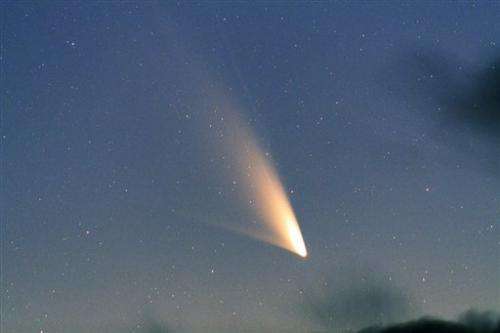Comet making closest approach ever of Earth (Update)

A recently discovered comet is closer than it's ever been to Earth, and stargazers in the Northern Hemisphere finally get to see it.
Called Pan-STARRS, the comet passed within 100 million miles (160 million kilometers) of Earth on Tuesday, its closest approach in its first-ever cruise through the inner solar system. The ice ball will get even nearer the sun this weekend—just 28 million miles (45 million kilometers) from the sun and within the orbit of Mercury.
The comet has been visible for weeks from the Southern Hemisphere. Now the top half of the world gets a glimpse as well.
The best viewing days should be next Tuesday and Wednesday, when Pan-STARRS appears next to a crescent moon at dusk in the western sky. Until then, glare from the sun will obscure the comet.
California astronomer Tony Phillips said the comet's proximity to the moon will make it easier for novice sky watchers to find it. Binoculars likely will be needed for the best viewing, he said, warning onlookers to avoid pointing them at the setting sun.
"Wait until the sun is fully below the horizon to scan for the comet in the darkening twilight," Phillips advised in an email sent from his home and observatory in the Sierra Nevada mountains.
Pan-STARRS' name is actually an acronym for the Hawaiian telescope used to spot it two years ago: the Panoramic Survey Telescope and Rapid Response System. The volcano-top telescope is on constant prowl for dangerous asteroids and comets that might be headed our way.
Thought to be billions of years old, the comet originated in the distant Oort cloud—a cloud of icy bodies well beyond the orbits of Neptune and Pluto—and somehow got propelled toward the inner solar system. It's never passed by Earth before, Phillips said.
A much brighter comet show, meanwhile, is on the way.
Comet ISON may come close to outshining the moon in November. It was discovered last September by Russian astronomers and got its acronym name from the International Scientific Optical Network.
Neither Pan-STARRS nor ISON pose a threat to Earth, according to scientists.
More information: NASA: apod.nasa.gov/apod/ap130305.html
Space Weather: spaceweather.com/
Copyright 2013 The Associated Press. All rights reserved. This material may not be published, broadcast, rewritten or redistributed.





















